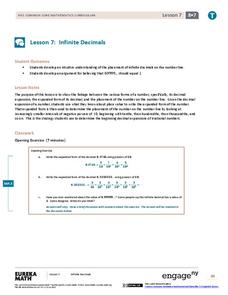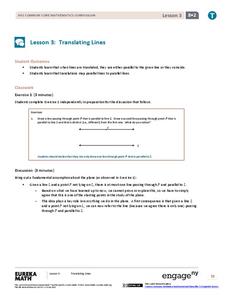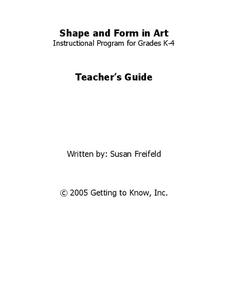EngageNY
Infinite Decimals
Can you support the argument that the decimal 0.99999 ... is equivalent to the number one? The seventh installment in this 25-part module gives convincing support for this conclusion. Pupils write infinite decimals using powers of 10....
EngageNY
Writing and Expanding Multiplication Expressions
Find out what's so standard about standard form. Scholars learn to write multiplication expressions with variables in the 10th lesson in a series of 36. They use different symbols for multiplication and translate between standard and...
EngageNY
Linear and Nonlinear Expressions in x
Linear or not linear — that is the question. The lesson plan has class members translate descriptions into algebraic expressions. They take the written expressions and determine whether they are linear or nonlinear based upon the...
EngageNY
Exponential Notation
Exponentially increase your pupils' understanding of exponents with an activity that asks them to explore the meaning of exponential notation. Scholars learn how to use exponential notation and understand its necessity. They use negative...
EngageNY
Definition of Translation and Three Basic Properties
Uncover the properties of translations through this exploratory lesson. Learners apply vectors to describe and verify transformations in the second installment of a series of 18. It provides multiple opportunities to practice this...
EngageNY
Translating Lines
Define parallel lines through transformations. The third lesson of 18 examines the result of the translation of a line. Two possible outcomes include coinciding lines and parallel lines.
EngageNY
The Relationship Between Visual Fraction Models and Equations
Ours is to wonder why, not just to invert and multiply. The seventh installment of a 21-part module uses fraction models to help pupils understand why the invert-and-multiply strategy for dividing fractions works. They then work on some...
EngageNY
Find Solutions to Make Equations True
The truth is always best. Individuals continue to find values that make equations true in the 26th installment of the 36-part module. The only difference is that they now call them solutions to those equations.
Partnership for Educating Colorado Students
Mayan Mathematics and Architecture
Take young scholars on a trip through history with this unit on the mathematics and architecture of the Mayan civilization. Starting with a introduction to their base twenty number system and the symbols they used, this eight-lesson unit...
Ed Migliore
Linear Equations in Two Variables
This traditional textbook style unit includes vocabulary, a direct explanation section, examples, practice problems that directly line up with the explanations and examples, and a unit summary review and practice problems. Learners get...
Getting to Know
Shape and Form in Art
Introduce youngsters to the important role shape and form play in art with this extensive collection of activities and projects. From teaching first graders how to create mandalas to engaging third and fourth graders in the design...
Curated OER
Subtraction: Take away and find the difference
Subtraction, take away, and compare the difference are the topics of this comprehensive presentation. Budding mathematicians will count balls, then watch as they are taken away. They will then view two sets of balls and compare the...
Scholastic
Study Jams! Greatest Common Factor
When one method isn't enough to teach GCF, try two! This interactive webpage introduces factors and the prime factor tree to find the greatest common factor of two numbers. After the lesson, have learners click to try the two examples...
Scholastic
Study Jams! Decimal & Fraction Equivalents
If a candy bar costs 3/4 of a dollar, can your mathematicians figure out the cost in cents? After watching this animated video, your learners will see that every fraction can be a decimal and every decimal can be a fraction. The video...
Scholastic
Study Jams! Relate Multiplication & Division
Sometimes the easiest way to understand division is to look at it as multiplication. Show your mathematicians that every problem can be written backward to make it easier for them. The video explains how the relationship between...
Scholastic
Study Jams! Add & Subtract with Unlike Denominators
Your bakers might not realize that they need to know how to add with unlike denominators in order to figure out how much milk they need for a recipe. In order to make brownies and cookies, this lesson teaches how to find a common...
Scholastic
Study Jams! Types of Lines
Get jamming with lines and sing along to this karaoke that reviews the main types of lines. Your learners can't forget the main properties of lines when they sing the chorus on the karaoke song after the included slide show. The slides...
Scholastic
Study Jams! Pictograph
An easy and fun way to look at data is with a pictograph. A lesson plan friendly enough for multiple grade levels shows how to set up this graph with a corresponding key. The steps review the importance of choosing an appropriate...
Scholastic
Study Jams! Identify Outcomes and Make Predictions
Boy, girl, girl, boy? Make a prediction on what kind of puppies you are going to get during this video that introduces outcomes. Knowing how to make an educated prediction is even more important, and this lesson focuses on what to...
Scholastic
Study Jams! Customary Units of Length
See if your mathematicians can go from miles to yards to feet and back again with unit conversions. This video introduces the topic of the customary units of length and common equivalents. The main rule is to multiply when making...
Scholastic
Study Jams! Double-Line Graphs
With two summers of babysitting money, Mia needs a way to compare her earning from both years. Show your learners that they can organize the data onto a double-line graph to easily compare which summer was more profitable. The lesson...
Scholastic
Study Jams! Histograms
With so many ways to organize data, a histogram is useful when we need to graph a variety of ranges. The interactive lesson plan organizes heights into different categories, not too big and not too small, to display on a histogram. The...
Scholastic
Study Jams! Order Whole Numbers
Mia's been practicing for the hundred yard dash and wants to know if she's improving. Help order her race times from greatest to least while learning how to compare numbers using place value. A variety of additional examples are included...
Scholastic
Study Jams! Combinations
With so many combinations, this colorful video allows your learners to mathematically figure out how many options they have when purchasing t-shirts. One instructional activity teaches how to find out the combinations, and the second...
Other popular searches
- Math Vocabulary Activities
- Esl Math Vocabulary
- Math Vocabulary Games
- Math Vocabulary Games Ell
- Math Vocabulary Cards
- Division Math Vocabulary
- Math Vocabulary Drawings
- Grade 4 Math Vocabulary
- Math Vocabulary Affixes
- Vocabulary Development Math
- Math Vocabulary Lesson
- Math Vocabulary Introduction













